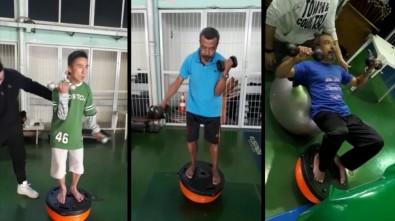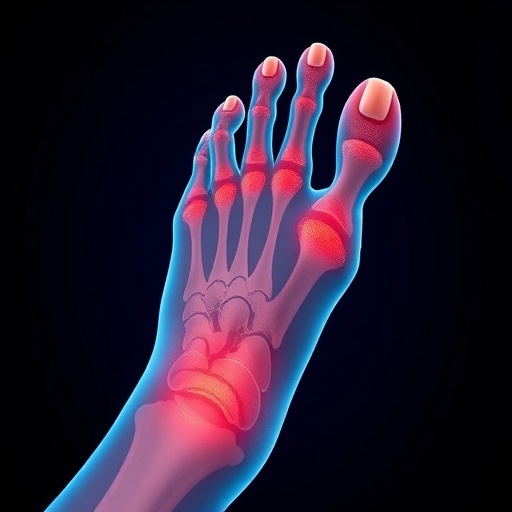Brazilian researchers use complex training program to stimulate different motor and cognitive skills simultaneously and restore brain regions associated with freezing of gait in advanced-stage patients

Credit: Carla da Silva Batista
Freezing of gait, one of the most incapacitating symptoms of Parkinson’s disease, manifests as sudden, short episodes of an inability to move the feet forward despite the intention to walk. Researchers at the University of São Paulo (USP) in Brazil have shown that the disorder can be mitigated by means of a complex physical exercise protocol designed to stimulate different motor and cognitive skills simultaneously. An article on the study is published in the journal Movement Disorders.
The study, supported by FAPESP, also showed that resistance training with instability modified brain regions associated with the physiological alterations typical of gait freezing, boosted neuron activation, and enhanced brain plasticity in the affected regions.
“In addition to positive reports from the patients who took the training, clinical trials also evidenced significant improvements, especially a 60% reduction in gait freezing and a 70% reduction in motor symptoms of the disease. Another important outcome concerned the restoration of brain regions directly linked to the problem. Brain plasticity in these areas is a predictor of gait freezing mitigation,” Carla da Silva Batista, a researcher in USP’s School of Physical Education and Sports and first author of the article, told Agência FAPESP.
Reactivation of brain regions was verified by functional magnetic resonance imaging (fMRI). The protocol is the first to reduce symptoms of gait freezing, clinically assessed in an objective manner, and to record the associated pathophysiologic alterations in the brain.
The study was part of Batista’s postdoctoral research, and some of it was conducted at Oregon Health and Science University (OHSU) in the United States with support from FAPESP via a scholarship for a research internship abroad.
According to Batista, activation of the cerebellar area, associated with gait automaticity, and the mesencephalic locomotor region, associated with gait initiation and postural control, explains the reversal of gait freezing after adapted resistance training.
Common cause of falls
There are no specific treatments for gait freezing, which is one of the most common causes of falls among Parkinson’s patients and, alongside tremor and cognitive impairment, responsible for loss of quality of life.
Gait freezing is estimated to affect some 26% of moderate patients and 80% of advanced-stage patients. It usually occurs while the patient is walking: feet appear to be “stuck” but the upper body continues to move, and fractures, as well as falls, may result, leading to premature hospitalization. It also occurs when the patient is rising from a seated position and stumbles. “We don’t know the exact cause but we know of several key predictors, such as heavy use of medications for Parkinson’s, progress of the disease, severe cognitive decline, stress, and anxiety,” Batista said, adding that patients may have all or several of the predictors without suffering from freezing of the gait.
Adapted resistance training with instability
The study conducted by the USP research group had 32 participants in stages 3 and 4 of the disease (deemed to have five stages). They were randomly divided into two groups. One comprised 15 patients and received conventional rehabilitation physical therapy, serving as a control group. The other, with 17 patients, took the complex training program designed by the researchers. The program consisted of 36 sessions spread over a 12-week period and involving exercises that combined instability, weight lifting, motor coordination, and cognitive demands.
“The exercises are intense and must be performed concurrently to cause complexity. This demands considerable effort from the patient and confidence on the part of the trainer, who will invariably have to give patients some support so they don’t fall,” Batista said.
Complexity is necessary to achieve the desired result. “Exercises involving motor complexity are known to be more effective when performed together. Studies in animal models confirm this, enhancing neuroplasticity by forming neurons and synapses in certain brain regions. This is exactly what we wanted to achieve,” she explained.
The degree to which the disorder was mitigated and brain plasticity enhanced was assessed using a fMRI analysis model developed previously by researchers affiliated with USP in partnership with colleagues in the UK and US, including one at OHSU, and published in Scientific Reports in 2017.
“Using this model they measured activity in the brain regions involved in freezing of gait before and after 12 weeks of training,” Batista said. “The methodology proved reversal of the disorder and enhanced plasticity in the brain regions concerned.”
In the study no improvement was observed in the control group. “It’s important to stress that the traditional exercises were unable to mitigate the severity of gait freezing or bring about positive alterations to brain regions,” Batista said.
Combined exercises
Although the causes of gait freezing are poorly understood, the researchers designed the training program to address the difficulties typically experienced by patients with the disorder, and hence to include sensorimotor, weightlifting, motor coordination and cognitive demand exercises simultaneously.
Most patients who suffer from gait freezing experience difficulties with proprioception (how the body senses its position in space), motor coordination, muscular strength, and cognitive function. “This is why we use exercises that involve strength and coordination while trying to maintain balance [on a half-ball or disk],” Batista said. “Cognitive impairment is also a predictor of gait freezing, so we include cognitive tasks and dual-task exercises that require simultaneous attention to two activities or mental flexibility to switch from one task to another as necessary.”
Strength training is also important for Parkinson’s patients, as muscle weakness is another symptom of the disease. “Weights are part of most exercises in our program, which isn’t easy. It demands quite a lot of the patient. Many volunteers in our study said they enjoyed the challenge and felt stronger as time passed, which motivated them to continue,” Batista said.
###
About São Paulo Research Foundation (FAPESP)
The São Paulo Research Foundation (FAPESP) is a public institution with the mission of supporting scientific research in all fields of knowledge by awarding scholarships, fellowships and grants to investigators linked with higher education and research institutions in the State of São Paulo, Brazil. FAPESP is aware that the very best research can only be done by working with the best researchers internationally. Therefore, it has established partnerships with funding agencies, higher education, private companies, and research organizations in other countries known for the quality of their research and has been encouraging scientists funded by its grants to further develop their international collaboration. You can learn more about FAPESP at http://www.
Media Contact
Heloisa Reinert
[email protected]
Original Source
https:/
Related Journal Article
http://dx.




